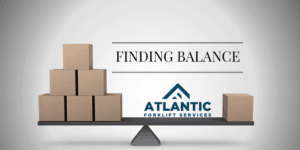 Balance. We’re all working to achieve it, some with more success than others. Balance is critical to the successful, safe operation of your forklift as well.
Balance. We’re all working to achieve it, some with more success than others. Balance is critical to the successful, safe operation of your forklift as well.
Forklifts achieve balance in two ways.
A Counterbalance forklift is a truck that can lift and move a load without the use of outriggers to stabilize the unit. These forklifts usually have the counterbalance attached to the back of the forklift. In fact, in a battery-operated forklift, the batteries themselves act as the counterbalance, as they can weigh several thousand pounds.
Counterbalance forklifts are the most common forklifts in the materials handling industry. These lifts allow the operator to come right up on a load before picking it up or off-loading it. A forklift with outriggers will only be usable if the area you are working in allows for your stabilizers to be extended.
A Reach truck is a standup unit equipped with outriggers that does allow the carriage and the forks to extend from the truck to reach the item being moved. Imagine your product is in the rack, but on the floor- you wouldn’t be able to get the forklift close to the rack because of the outriggers. Reach trucks can be acquired with single and double reach to compensate for this.
Reach trucks are used almost exclusively in warehouses with little space to move around.
Most Reach trucks are used indoors. In an environment where weather is a factor, an electric Reach truck outdoors is not advised. They are also built very low and uneven surfaces will damage the undercarriage. For outdoor use, we strongly recommend a Counterbalance forklift.
Finally, general operation of these two types of lifts are worlds apart. Targeted, specific training for both units is necessary.
If we’ve left you with questions about the difference between Counterbalance and Reach forklifts, do not hesitate to contact us.
